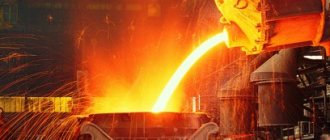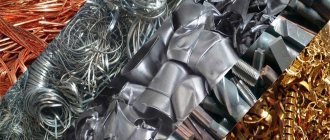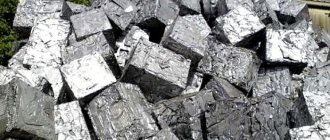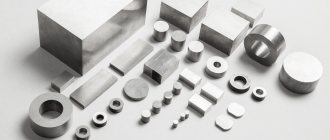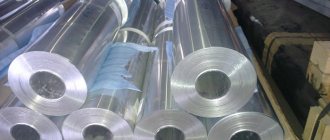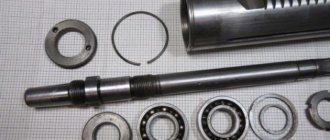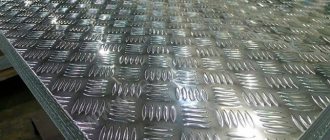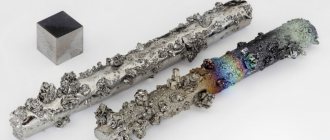- home
- Articles
- Distinctive properties of ferrous and non-ferrous metals
The metal is used to make various products for industrial, agricultural and household purposes. It is used everywhere and it is difficult to imagine any sphere of human life without it. Depending on the composition, ferrous and non-ferrous metals are distinguished. But not everyone knows what the differences are between these two types. Let's look into this issue.
Properties
The group of ferrous metals includes iron and all its alloys. They make up about 90% of all material used in the economy. They are rare in nature, so the material is extracted by processing iron ore. The main difference between ferrous metals is that they always contain iron. Colored ones do not contain it; they are usually found in different colors. This is where the name came from. Non-ferrous metals differ from each other in technical capabilities and composition, while ferrous metals are all similar to each other, since they mainly consist of iron.
The properties of ferrous metal appear only after changing its composition; we list the main advantages of this material:
- easy weldability;
- high hardness;
- increased strength;
- low cost;
- resistance to mechanical damage;
- sufficient volume for use for production purposes.
Thanks to these qualities, ferrous metal is increasingly used in construction to create civil and industrial structures. The buildings can withstand high loads and have a long service life.
Non-ferrous metals are more expensive due to the fact that they are scarce, but alloys are used to produce devices and products with limited properties.
Properties of non-ferrous metal:
- scrap of this material is suitable for recycling;
- it does not corrode;
- has high thermal conductivity;
- weighs lighter when compared with ferrous metal;
- more plastic and flexible.
Iron
Iron is a common element. Its amount in the earth's crust is estimated at a few percent, but iron is mined from rich ores containing at least 25 percent metal.
Iron ores
The types of iron deposits are very diverse. The most important are the so-called ferruginous quartzites - thin-banded rocks in which black stripes - iron minerals magnetite - magnetic iron ore and less hematite - red iron ore - are interlayered with ribbons of light quartz.
Such deposits contain many billions of tons of iron ore and are known mainly from the oldest strata, two or more billion years old! They are developed in ancient crystalline shields and platforms. They are widespread in North and South America, western Australia, Africa, and India.
Reserves of this type of iron ore are practically limitless - more than 30 trillion tons, a truly astronomical figure! It is assumed that ferruginous quartzites were formed by the action of iron bacteria in ancient basins due to iron that came in solutions from the surrounding hills, and perhaps in hot deep solutions.
Sedimentary iron ores are deposited in lakes and seas—modern “natural laboratories.” In recent years, secretions of iron nodules (nodules) at the bottom of the oceans have been discovered. They contain huge reserves of not only iron, but also manganese, nickel and other elements accompanying it.
The types of iron deposits also include the so-called contact or skarn deposits, which are located on the border of granite rocks and limestones and are formed due to solutions brought from the magmatic body.
Deposits of this type are composed of rich ores. Iron minerals appear to be scarce. The main ones are: magnetite, hematite, as well as various varieties of brown iron ores, siderite (iron carbonate). These minerals produce a wide variety of deposit types.
Main types
Compared to black, non-ferrous metal has many more varieties. The addition of various substances to the composition led to the fact that the material began to be classified into seven groups. Non-ferrous metal has refractory, light and heavy, dispersed, rare earth, radioactive, noble, dispersed materials. We will not list all these types, but will focus only on the most popular metals and their properties:
- Copper. Included in the list of elements that make up up to 98% of the earth's crust. It has no magnetic properties and has high electrical conductivity. Used to create wiring, pipes, technical elements.
- Lead. In terms of prevalence, this alloy ranks fourth in manufacturing processes. Suitable for electrically conductive elements, but not used as often as it is considered toxic.
- Brass. It is superior to copper in strength. Used for the production of pipes, sheet metal, foil, wire.
- Zinc. Refers to heavy non-ferrous metals. Used to create alloys and as anti-corrosion protection for ferrous metals. In its pure form it is used only in the pharmaceutical and manufacturing industries.
- Aluminum. It is used more often than others for production due to its light weight. It is not modified by external factors, therefore it is widespread in the consumer market.
Ferrous metal does not have many alloys; only 2 varieties are used for industrial purposes:
- Steel. It is a ferrous metal used in many industries. It contains about 99% iron, the rest is carbon. When other substances are added, they increase the strength of the metal, protect against corrosion, and make it resistant to temperature changes. Some steel grades are used for secondary production.
- Cast iron. It contains more carbon (about 5%). It is used in industry and production, but it weighs a lot, so it is not applicable everywhere. After use, cast iron is poured into steel.
Features of non-ferrous metals
Each of the metals in this group has properties that largely determine its membership in it. This also determines the use of non-ferrous metals in many areas of industry.
So, for example, most of them have high heat capacity and thermal conductivity, which gives them the ability to quickly cool after welding. There is a downside to this: when working with metals such as magnesium and copper, you need to heat them up just before welding, and you need to use strong heat sources during the process to keep them from cooling.
Another characteristic property is a decrease in mechanical properties. In view of this, it is necessary to work with them carefully to avoid deformation.
Non-ferrous metals actively react with gases during heating. Titanium, molybdenum and tantalum clearly demonstrate this property.
This group of metals can be used for a long time, but they need to be protected from oxygen, which destroys metals. For this purpose, the conductors are, for example, coated with a protective varnish. The metal is first subjected to a two-layer priming procedure.
Application area
Non-ferrous metal is used to create parts for cars, ships and aircraft. They are used to make metal structures, jewelry, and art objects. Alloys of non-ferrous metals are used in industry and medicine. With their help, equipment, hypodermic needles, and instruments for performing operations are created. Iridium is taken during radiation therapy, and gold and platinum are used in dentistry.
Ferrous metals are actively used in the food industry, in the creation of electrical engineering and energy generation. In the construction of houses, industrial buildings and cars, they are used more often than non-ferrous metal. Some alloys are specially created for harsh operating conditions, adding impurities that will make the material more stable, more reliable, etc.
Manganese
Manganese is similar to iron in terms of formation conditions and technical applications .
Sedimentary ores
It usually accompanies iron in sedimentary ores and ancient metamorphic deposits. It, like iron, the basis of ferrous metallurgy, is used to produce high-quality steels.
Recycling
Due to increased production turnover and consumer demand, more and more organizations are engaged in recycling scrap. If you don’t take care of waste, the environment and people will soon suffer, since some materials are dangerous to health and the environment.
Recycling is available for ferrous and non-ferrous metals. The most valuable raw materials for this process are found in batteries, batteries and household appliances. The process of processing raw materials involves several stages:
- Reception of scrap metal, weighing and payment.
- Sorting at a special point by profile and variety. This is the most labor-intensive stage and takes a lot of time.
- Dividing the material into small fragments for convenient transportation and further processing.
- Cleaning from impurities manually or using special devices.
- Melting down material for reuse.
For large enterprises, the delivery of metal allows them to reduce costs. It is such organizations that mainly influence the environmental situation, since consumers do not produce waste on such a scale.
Non-ferrous and ferrous metals are used in almost all sectors of human life. Knowing how to distinguish them from each other will allow you to take into account the strengths and weaknesses of the material in advance, as well as plan in advance for their recycling and reuse.
Chromium
Chromium also belongs to the ferrous metals . Its main mineral, chromite, forms black solid masses and inclusions of crystals in ultrabasic rocks.
Chromite deposits
Chromite deposits , as well as the enclosing massifs of ultrabasic rocks, are found in zones of deep faults. Ore-bearing magma came from the subcrustal depths, from the mantle. Chromite deposits are known in South-West Africa, the Philippines, Cuba, and the Urals.
Chromium is used in metallurgical production to impart special hardness to steel, in chrome plating of metal surfaces and in the production of paints; it gives compounds a green color.
Vanadium
Vanadium
is also important - a frequent companion of titanium in deposits and placers, used for the production of especially strong grades of steel used in the production of armor and projectiles, in the automotive industry, and in nuclear energy.
Here, new combinations of elements in alloys are becoming increasingly important. For example, an alloy of vanadium with titanium, niobium, tungsten, zirconium, and aluminum is used in the production of rockets and in nuclear technology. And new composite materials are also prepared from mineral raw materials.
Titanium
Titanium belongs to the same technical group . It is mined from basic igneous rocks in the form of ilmenite and from placers, terrestrial and very widespread on sea beaches and shelves (Brazil, Australia, India), where its source is titanomagnetite, ilmenite and rutile.
Titanium is used in the production of special grades of steel. It is a heat-resistant, lightweight metal.
